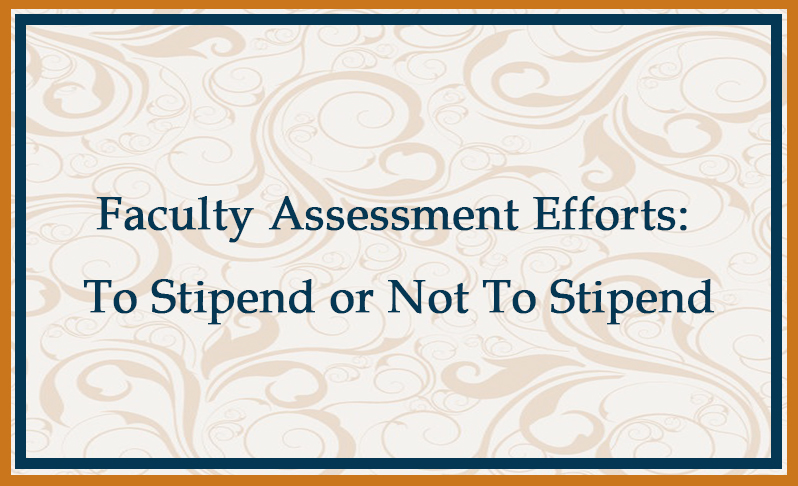Assessment is a people process – not a person process – a people process. In higher education, the people are the faculty. It’s always a bit of a surprise that in the world of higher education where shared governance and decision-making are sacrosanct, faculty members often take little interest in assessment. That irony aside, assessment in higher education MUST include faculty.
The challenge, of course, is how to change policies and practices in a way which will increase faculty involvement in assessment. There it is. It’s finally been said. Enhancing faculty involvement in assessment means change.
Related Reading: The Ins and Outs of Higher Education’s Culture of Assessment
Initiating Change
Change can be mandated, but that type of change is hardly engaging, almost impossible to sustain, and does little to create the coveted culture of assessment so often referred to in higher education. In reality, assessment by command creates the antithesis of a culture of assessment – an environment where assessment is relegated to a few administrators who chase down faculty for contrived and often meaningless information in effort to meet burdensome accountability demands.
As an alternative to mandates, administrators on many campuses attempt to use extrinsic rewards to increase faculty involvement. These incentives come in varied forms including stipends.
Will incentivizing assessment efforts actually change the level of faculty involvement in the process? Well, it depends. Because change is complex, it might be helpful to reference a bit of change theory. Kurt Lewin’s (1951) seminal portrayal of change still offers a suitable framework for a contemporary discussion of change. According to Lewin, change involves three steps.
- Unfreezing or disrupting status quo behaviors
- Moving to and reinforcing new behaviors
- Refreezing or stabilizing new behaviors
Stipends work well to unfreeze current behaviors. Individual faculty member stipends can serve as a counter balance to the risks of trying something new in a course assessment. Stipends awarded to programs can broaden faculty involvement in program assessment efforts and offer compensation for the faculty’s investment of time. When criteria for stipends require recipients to share their efforts with colleagues, the thaw initiate by the original investment increases.
If stipends unfreeze existing behaviors, recognition reinforces new behaviors. Recognition of the exemplary assessment efforts of a faculty member or program conveys the value of assessment to others on campus. Publishing assessment accolades on websites or highlighting them during faculty events takes few resources but reaches a large audience. This type of recognition underscores the value of the new behaviors and at the same time provides exemplars which can guide future assessment efforts of others.
Related Reading: Assessment is a Team Sport: A Collaborative Faculty Process
Sustaining Change
True change implies long-term, sustainable returns. In Lewin’s terms, refreezing embeds new behaviors into an organization’s ethos and improves the odds it will stick. Refreezing assessment efforts can only be accomplished by rewarding faculty for assessment efforts. While stipends can jump-start initial assessment efforts and recognition can reinforce behaviors, rewards stabilize and hopefully institutionalize the efforts.
There are a couple of caveats. Rewarding assessment only as a faculty service activity will thwart attempts to establish a culture of assessment. To galvanize an institutional culture of assessment, campus structures must reward assessment as a legitimate teaching activity. This does not have to be difficult. Teaching awards are common-place on most campuses. Adding an award (or two) highlighting assessment’s impact on student learning requires minimal resources but publically validates assessment as a critical component of teaching.
However until assessment intersects with research, widespread faculty involvement will be difficult to achieve. Rewarding research related to assessment may not be as challenging as it sounds. Campuses can do two things. First, internal mini-grants can be earmarked for assessment research. This type of funding offers great opportunity for junior faculty to secure a seed grant and to be engaged, from the outset of their career, in assessment. Second, campuses can elevate action research within the promotion and tenure process. Action research and assessment make great partners. Both are participative and emerge and respond to situational context.
Related Reading: 3D Assessment: Using Data, Discussions and Decisions to Engage Faculty
Final Thoughts
Yes, even small assessment stipends will require resources, and resources are limited. As in most organizations, anticipated return on investment and institutional values drive campus resource allocation. Higher education has been clamoring about increasing faculty engagement in assessment for years. In terms of building a campus culture of assessment, stipends actually offer a way to put the proverbial money where the mouth is in terms of assessment.
References:
Lewin K. 1951. Field Theory in Social Science. New York: Harper & Row.
Author
 Dr. Connie Schaffer is an Assistant Professor in the Teacher Education Department at the University of Nebraska Omaha (UNO). She serves as the College of Education Assessment Coordinator and is involved in campus-wide assessment efforts at UNO. Her research interests include urban education and field experiences of pre-service teachers. She co-authored Questioning Assumptions and Challenging Perceptions: Becoming an Effective Teacher in Urban Environments (with Meg White and Corine Meredith Brown, 2016).
Dr. Connie Schaffer is an Assistant Professor in the Teacher Education Department at the University of Nebraska Omaha (UNO). She serves as the College of Education Assessment Coordinator and is involved in campus-wide assessment efforts at UNO. Her research interests include urban education and field experiences of pre-service teachers. She co-authored Questioning Assumptions and Challenging Perceptions: Becoming an Effective Teacher in Urban Environments (with Meg White and Corine Meredith Brown, 2016).



